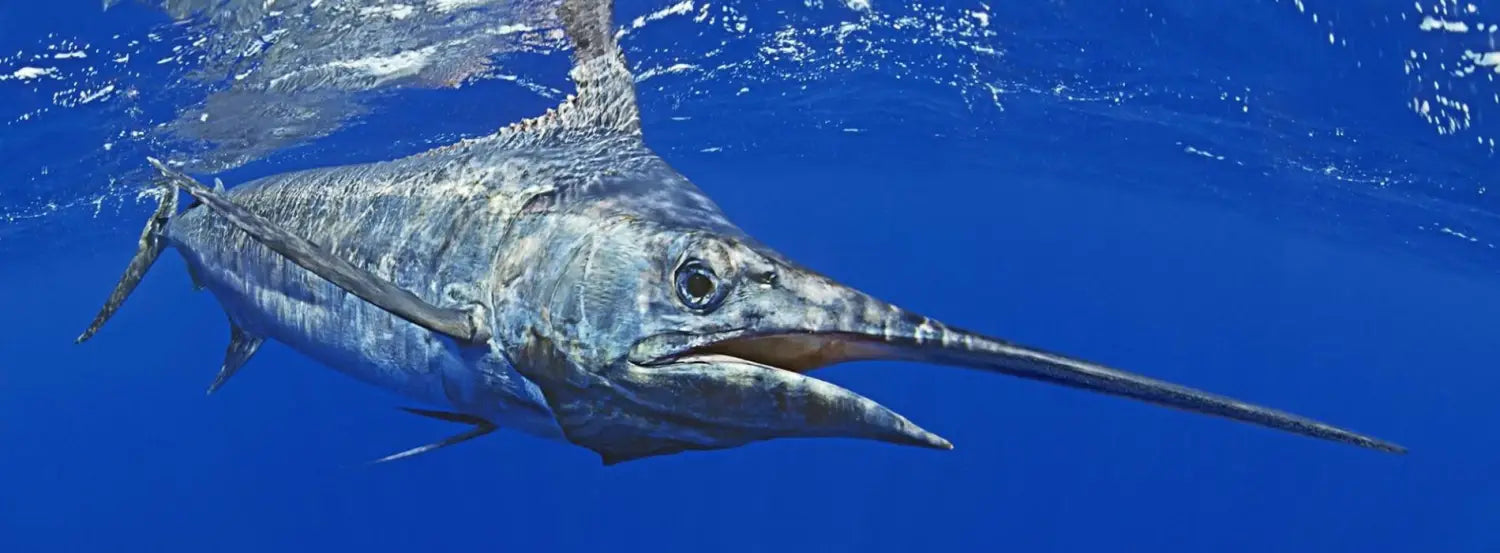The ocean is a vast and mysterious world, home to a myriad of fascinating creatures. One such creature that captures the imagination is the swordfish. With its sleek body, long bill, and powerful swimming ability, it is a true marvel of the sea. In this article, we will explore its life and characteristics, its behavior, habitat, and the conservation efforts in place to protect this magnificent species.
1. Introduction to the Swordfish
This marlin , scientifically known as Xiphias gladius, is a large predatory fish that belongs to the billfish family. It is characterized by its long, flat bill, which resembles a sword and gives the fish its name. It has a streamlined body, a crescent-shaped tail, and a dorsal fin that runs the length of its back.
Physical Appearance
The swordfish is a truly impressive creature in terms of size and strength. It can reach lengths of up to 14 feet and weigh over 1,400 pounds, making it one of the largest species of fish in the ocean. Their body is covered in smooth, scaleless skin, which ranges in color from dark blue to brownish-black on the upper body and silver-white on the belly.

Habitat and Distribution
This marlin is found in both the Atlantic and Pacific Oceans, inhabiting both warm and temperate waters. In the Atlantic, they can be found in the North Atlantic, from the Gulf of Mexico to the Grand Banks of Newfoundland. In the Pacific, they are found in the waters off the coast of California, Mexico, and as far west as Japan. they are highly migratory and can cover vast distances in search of food and suitable breeding grounds.
2. Life Cycle and Reproduction
The life cycle of the swordfish is truly remarkable, with several distinct stages that span many years. Let's take a closer look at each stage:
Larval Stage
Their begins as a tiny larva, hatched from eggs that are released into the water column by adult females. These larvae are only a few millimeters long and are completely transparent, making them difficult to spot in the vastness of the ocean. They drift with ocean currents, feeding on plankton and small organisms until they reach a length of about 2 inches.

Juvenile Stage
As the larvae grow, they undergo a transformation into juvenile. At this stage, they develop the distinctive long bill and begin to take on the shape and characteristics of an adult. Juvenile swordfish seek out areas with abundant food, such as the edge of the continental shelf or areas with upwelling currents. They grow rapidly during this stage, feeding on a diet of small fish and squid.
Adult Stage
Once they reach adulthood, it begins its impressive journey as a powerful and skilled predator. An adult have a diverse diet that includes squid, octopus, and various species of fish, including tuna and mackerel. They are known for their incredible speed and agility, capable of swimming at speeds of up to 50 miles per hour. This makes them formidable hunters in the open ocean.

Reproduction
They reach sexual maturity at around 4 to 5 years of age. During the breeding season, females release their eggs into the water, while males release sperm to fertilize them. The exact details of their reproduction are not well understood, as spawning occurs in deep waters and is difficult to observe. After spawning, the adult swordfish return to their usual feeding grounds, leaving the eggs and larvae to develop on their own.
3. Feeding Behavior and Adaptations
It is a voracious predator, with a number of unique adaptations that make it an efficient hunter in the open ocean. Let's explore some of these adaptations and the feeding behavior of the swordfish:

The Sword-like Bill
Their most distinctive feature is its long bill, which is used as a powerful weapon. The bill is used to slash at prey, stunning or impaling them, making it easier for the swordfish to capture and consume its meal. The bill is also capable of detecting electrical signals emitted by prey, helping them to locate its next meal.
Deep Diving
They are known for their ability to dive to great depths in search of food. They are capable of diving down to depths of over 1,800 feet, where they can find prey that other predators cannot reach. This diving behavior is facilitated by adaptations such as a large, oil-filled liver that helps with buoyancy and a heat exchange system that allows the swordfish to maintain a stable body temperature in cold waters.
Feeding Strategy

This marlin employ a unique feeding strategy known as "ram feeding." This involves swimming at high speeds toward a school of fish or a group of squid and using their bill to slash at the prey. This sudden burst of speed and powerful strike can stun or kill the prey, making it easier for them to consume its meal.
4. Fisheries and Conservation
This creature has been an important target species for commercial and recreational fishing for many years. However, overfishing and the use of unsustainable fishing methods have led to concerns about the long-term viability of their populations. As a result, fisheries management measures and conservation efforts have been put in place to ensure the sustainability of this iconic species.
Fishing Regulations

To protect swordfish populations, fishing regulations have been implemented to limit the number and size of fish that can be caught. These regulations include size limits, catch quotas, and restrictions on fishing gear and methods. By implementing these measures, fisheries can help ensure that their populations remain healthy and abundant.
Bycatch Reduction
One of the main challenges in their fisheries is the issue of bycatch, which refers to the unintentional capture of non-target species. Bycatch can include endangered or protected species, such as sea turtles and marine mammals. To reduce bycatch, fisheries have implemented measures such as the use of circle hooks, which can reduce the likelihood of catching non-target species.
Sustainable Seafood Practices
Consumers can also play a role in the conservation of swordfish and other marine species by making informed choices about the seafood they consume. By choosing sustainably sourced seafood, such as this marlin caught using environmentally friendly fishing methods, consumers can support fisheries that are working to protect the ocean and its inhabitants.

Ourl ast word...
This fish is a truly remarkable creature, with its sleek body, powerful swimming ability, and iconic bill. Its life cycle, feeding behavior, and adaptations make it a fascinating subject of study for marine biologists and a symbol of the beauty and diversity of the ocean. Through responsible fishing practices and conservation efforts, we can ensure that future generations can continue to marvel at the majesty of the swordfish and other remarkable ocean creatures.
We hope you've liked this article about the espadon!
Feel free to subscribe to our private newsletter to receive more exclusive article. You will also receive a 10% bonus discount for our sea world catalogue. You will be notified via email whenever we release a new wonderful jewelry piece of the ocean.
Feel free also to go check out our website, we provide the best sea content and we offer you the best nautical jewelry all around the globe !





















